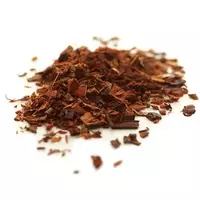Hanibush tea

In fact, tea is usually called not only drinks made from tea tree leaves. We think that few of us think when we enjoy the taste of karkade tea, roybos or hanibush that our favorite drinks are made from inflorescences, stems or leaves of herbs and plants, which have all the basic properties of tea, although they are not.
Such tea as hanibush is considered a relative of another famous tea from Africa called roybos. Hanibush tea is made from the plant of the same name, which grows in southern South Africa. The hanibush or Cyclopia plant belongs to the Bean family. Often the plant, as well as the hanibush drink, is called honey.
The useful properties of hanibush tea are primarily due to the vitamin-mineral composition of the drink, which contains a fairly large amount of some natural compounds that are really indispensable for the human body. For example, the chemical composition of hanibush tea is enriched with substances such as calcium, sodium, zinc, as well as iron, manganese and phosphorus.
Among the useful properties of hanibush tea is the ability of the drink to reduce the risk of osteoporosis diseases. In addition, regular consumption of hanibush tea helps to control blood cholesterol levels. Hanibush tea has antimicrobial, antifungal, and also antiviral properties.
The collection of natural raw materials for further processing for hanibush tea occurs during the flowering period of the South African plant belonging to the Legume family. It is worth noting that young leaves are used to produce hanibush tea, as well as inflorescences and stems of wild plants, since a species such as Cyclopia is not grown on an industrial scale.
For this reason, the natural material for hanibush tea is limited, hence the beverage is rather rare and expensive. The collected hanibusha leaves and inflorescences are folded into heaps and subjected to a natural fermentation process. Then raw material is dried in industrial stoves. At the last stage of making hanibush tea, the material is dried again, but this time in direct sunlight.
Next, hanibush tea goes through the stage of sorting and packaging. Such varieties of hanibush tea are distinguished as - small, very small and rough. For brewing in loose form, small hanibush tea is used. Very fine grinding of hanibush tea is used in the process of making tea in bags.
Hanibush tea is brewed in the same way as roybos or mate. In addition, honey or milk, as well as sugar, can be safely added to hanibush tea. It is worth noting that hanibush tea is often used as the basis for non-alcoholic cocktails.
hanibush tea 16 kKal
Energy value of hanibush tea (Ratio of proteins, fats, carbohydrates - ju):
Proteins: 0.83 g (~ 3 kCal)
Fats: 0.84 g (~ 8 kCal)
Carbohydrates: 1.17 g (~ 5 kCal)
Energy ratio (bj | y): 21% | 47% | 29%
 Español
Español Français
Français Português
Português Русский
Русский 简体中文
简体中文 繁體中文
繁體中文 日本語
日本語 한국어
한국어 العربية
العربية Türkçe
Türkçe Қазақ
Қазақ Deutsch
Deutsch Italiano
Italiano Українська
Українська
